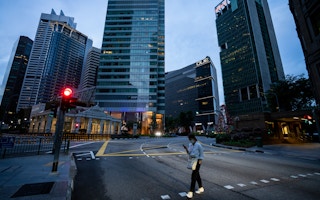With countries around the world beginning to emerge from lockdown, public health experts are warning against complacency as restrictions ease and schools, workplaces and stores reopen.
Until a vaccine against the SARS-CoV-2 is developed, countries must remain vigilant and curb community spread of the coronavirus to avoid a resurgence in cases.
Facilities managers and transport operators will need to play their part by ensuring that ‘high touch’ surfaces such as lift buttons and handrails are cleaned and disinfected, among other measures required to prevent cross-contamination.
According to Satish Bakhda, chief executive of Singapore-based cleaning and disinfection contractor Big Red, countries need a second line of defence to prevent a second wave of transmission.
“
The threat of a second wave of transmission is very real.
Teo Yik Ying, dean, Saw Swee Hock School of Public Health, National University of Singapore
When Singapore slowly lifts its partial-lockdown restrictions next month, businesses and employers need to consider how they can resume operations whilst ensuring the safety of their employees, customers, suppliers and the general public, he said.
Big Red has a simple solution to keep high-touch surfaces free of germs for a longer period of time: A disinfectant spray that forms a protective coating on surfaces and renders viruses unviable immediately upon contact. The product, known as BR Shield, is non-toxic, odourless and does not stain.
A single application of the spray can last for months, even with repetitive cleaning, and the company guarantees the product’s efficacy for half a year ‘or your money back’.
Regular disinfection with conventional chemical disinfectants can, to a certain extent, kill and reduce the number of pathogens present, but once the solution dries, any new pathogenic microorganisms re-introduced or not previously killed by the chemical disinfectant can survive and proliferate, quickly returning to unsafe, unhygienic levels, said Bakhda. “Conventional disinfectant only works for a few minutes. But what happens after that?”
When applied to surfaces such as lift buttons, touchscreens, door handles, handrails or toilet facilities, Big Red’s disinfectant spray reduces the risk of cross-contamination and disease transmission. This makes it attractive not only to offices, schools and hotels, but train and bus operators too, he said.
In Canada, it is deployed on buses and trains. In Singapore, the company has helped various government agencies coat its frequently touched surfaces, and the National University of Singapore is planning to use it on all lifts and escalators on campus. Big Red is also in talks with various hotels, schools and commercial buildings to treat all their high-touch surface areas before reopening in June, said Bakhda.
Professor Teo Yik Ying, dean of the Saw Swee Hock School of Public Health at the National University of Singapore, said: “The threat of a second wave of transmission is very real and looking at the situation in South Korea and China for the past few days, (we get an idea) of how challenging it is for countries to maintain a watertight response against Covid-19.”
How does the antimicrobial work?
Dr Martin Blake, Big Red’s chief technical adviser, explained that the coronavirus, like many other viruses was a negatively charged particle ribonucleic acid (RNA) enveloped in a shell of lipids and protein. The ribonucleic acid carries the pathogen’s genetic information.
BR Shield is a silane-based disinfectant that can bond chemically and physically to surfaces, creating a nanoscale, biostatic layer that is virtually indestructible. This durable coating is positively charged, therefore, the opposite to the viruses, explained Blake.
Additionally, the chemical formula of BR Shield creates a structure that can physically penetrate the outer surface of micro-organisms and completely disable them.
The positively charged coating first attracts the negatively charged viruses towards it and then, secondly physically destroys their outer protective shell, inactivating them. Whereas some disinfectants work on a short-term chemical basis, this is a long-term physical intervention with any treated surface providing continuous antimicrobial surface protection, said Blake.
In a new preliminary study, researchers at the University of Arizona found that the antimicrobial coating destroys coronavirus for 90 days.
Blake told Eco-Business the antimicrobial’s efficacy had also been proven in extensive tests with other coronaviruses that have a structure very similar to that of Covid-19.
How does Big Red’s disinfectant work? Source: Big Red
Dr Xiaojuan Khoo, a lecturer at Singapore University of Technology and Design, said: “Unlike common disinfectants, which kill pathogens upon application, antimicrobial sprays contain a polymer which bonds strongly to a variety of hard or soft material surfaces to form a protective shield capable of killing microbes over an extended period of time.”
Their purported versatility and long-term efficacy make such sprays attractive for use on high-touch surfaces to prevent the transmission of coronavirus and other pathogens, said Khoo, who did her PhD thesis on bacterial-resistant coatings.
However, she noted there was a lack of standardised antimicrobial tests for high-touch surfaces, and as such, the definition of a product’s effectiveness may vary from manufacturer to manufacturer. Few antimicrobial tests are performed under real-life conditions, and greater understanding of how factors such as humidity and temperature might affect antimicrobial outcomes is needed, she said.
Bakhda said the spray is not meant to replace existing cleaning and insufficient regular interim cleaning may, in fact, inhibit the coating’s performance. Treated surfaces need to be wiped regularly to remove debris and regenerate the protective coating. Otherwise, dust and other particles may accumulate, preventing viruses from reaching the antimicrobial layer, he explained.











